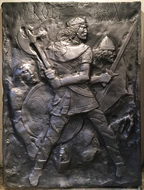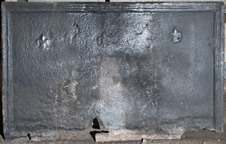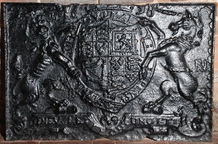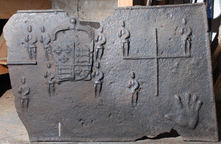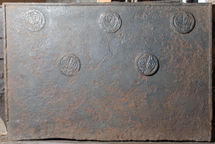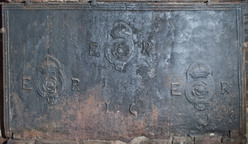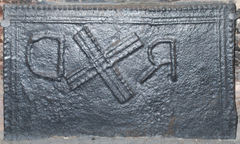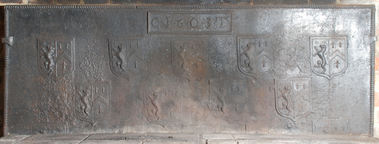-
1065
Description: Rectangular; no edging; rough background with 'incised' inscription across top in archaic lettering; central crowned male figure, in Saxon costume, standing astride and facing right, holding a battleaxe to his right in both hands; behind him to the right, a figure wearing a Norman-style helmet with nasal guard, advancing, with a shield, and a sword in his right hand; behind the central figure and to his right, a fallen figure with a circular shield covering him; below, the face of another fallen figure, also wearing a Norman helmet.
Notes: A dramatic pictorial fireback commemorating the Battle of Hastings. The pattern may have been made of a sculpted medium, such as clay.
Inscription: HAROLD REX
- Decoration tags:
- rectangular (shape)
- none (edging)
- whole carved pattern
- pictorial
- text
- humans
- objects
Manufactured: in the 20th century in England.
Current location: Mark Ripley Forge & Fireplaces, Northbridge Street, Robertsbridge, Salehurst, East Sussex, England.
- Attached to series:
- Commemorative firebacks
-
1166
Description: Rectangular shape; wide fillet and ogee-moulded edging; approximately top centre, initials RH, with date 1701 centred below.
Notes: A heavy casting, approx. 3cm thick; the character set for the initials and date lacks uniformity, some carved crudely, others more carefully; three horizontal planklines. The lettering differs from another fireback (see no. 1282), with the same initials and date, by the position and shape of the letter 'R'. Formerly in a house at Netherfield, East Sussex. The former location in the Netherfield area of these two firebacks suggests a possible association with Richard Hay, owner of land in that area at that time and ironmaster at Beech Furnace nearby.
Inscription: RH / 1701
- Decoration tags:
- rectangular (shape)
- fillet and ogee (edging)
- carved stamps
- individual letters
- individual numbers
- planklines
- text
Manufactured: in 1701 possibly at Beech Furnace, Battle in the Weald area of England.
Current location: Ripley Forge & Fireplaces, Northbridge Street, Salehurst, East Sussex, England.
- Attached to series:
- Date & initials firebacks
-
1283
Description: Rectangular shape; ogee-moulded edging; upper centred, small fleur-de-lys stamp impressed three times, the rightmost slightly higher than the other two.
Notes: A simple fireback of somewhat indeterminate date.
- Decoration tags:
- rectangular (shape)
- cyma reversa/ogee (edging)
- carved stamps
- heraldic
- objects
Manufactured: in the 17th century possibly in the Weald area of England.
Current location: Ripley Forge & Fireplaces, Northbridge Street, Robertsbridge, Salehurst, East Sussex, England.
- Attached to series:
- Miscellaneous stamp firebacks
-
644
Description: Formerly arched rectangular, arch now missing; cavetto-moulded edging, invected on the inner edge; English royal Stuart shield, garter, crown (mainly missing), supporters and motto; date split either side of crown; monogram to right of unicorn supporter.
Notes: The monogram probably identifies the pattern-maker, whose invected edging seems to be a distinctive style. From another fireback of the same design (no. 1018), complete with the arch, the height is approx 710mm.
Inscription: 1638 / HONI SOIT QUI MAL Y PENSE / RN / DIEV ET MON DROIT
Arms: English Stuart royal
- Decoration tags:
- rectangular (shape)
- invested cavetto (edging)
- whole carved pattern
- individual numbers
- monogram
- armorial
- royal
- text
Manufactured: in 1638 in England.
Current location: Six Poor Travellers House, High Street, Rochester, Kent, England.
Museum number: A4328 (part of the Rochester Guildhall Museum museum group)
- Attached to series:
- RN series
- Carolean royal armorial firebacks
- Stuart royal armorial firebacks
-
660
Description: Rectangular; plain plate; central, vertical cross-hilt dagger stamp; left side, fleur de lys stamp repeated five times, irregularly arranged in three rows, two above and below and one in the middle; right side, fleur de lys stamp repeated six times, four in a star above two in a row.
Notes: The dagger (length approx. 35cm), seen on two other firebacks (no. 595 and no. 1100), may have beeen of Italian manufacture. The form of the fleurs-de-lys identifies this fireback as one of the ‘Royal’ series, a large group bearing heraldic stamps.
- Decoration tags:
- rectangular (shape)
- none (edging)
- simple stamps
- carved stamps
- heraldic
- objects
Manufactured: in the mid-16th century in the Weald area of England.
Current location: Hole Park, Rolvenden, Kent, England.
- Attached to series:
- Knife & Dagger stamp firebacks
- Royal series
-
661
Description: Fragment; quasi-rectangular; twisted rope edging (top and sides), cavetto edging at bottom; originally, probably a symmetrical arrangement comprising a central, crude crowned, Tudor royal shield, with a standing human figure, its right arm bent at the elbow and its left arm crossing its waist, repeated in upper and lower positions on each side of the shield; to left and right, a twisted rope length repeated in the form of a cross, with the human figure placed above each transverse end and another below the cross and towards the shield; in the bottom corner(s), a (left) hand print.
Notes: The same crowned shield and use of hand print can be seen on a fireback at Etchingham (no. 60), indicating a common source.
Arms: Tudor royal
- Decoration tags:
- rectangular (shape)
- simple stamps
- carved stamps
- armorial
- royal
- humans
- objects
Manufactured: in the early- to mid-16th century in the Weald area.
Current location: Hole Park, Rolvenden, Kent, England.
-
662
Description: Rectangular; fillet edging (top and sides, except c.100mm at bottom of each side); arrangement of a circular butter print with fleur de lys design, repeated four times: one in each top corner, and two evenly spaced across the middle of the plate; a single circular butter print stamp with a heart-shaped design in the middle top position.
Notes: The fleur de lys stamp can also be seen on a fireback at Nymans, Handcross (no. 96); one of the Pounsley series of firebacks.
- Decoration tags:
- rectangular (shape)
- fillet (edging)
- simple stamps
- objects
Manufactured: in the mid- to late-16th century possibly at Pounsley Furnace, Framfield in the Weald area of England.
Current location: Hole Park, Rolvenden, Kent, England.
- Attached to series:
- Pounsley series
- Food mould stamp firebacks
-
1147
Description: Rectangular shape; triple fillet moulded edging (top and sides); overpressed stamp, repeated three times (top centre and below, to left and right) of a crowned rose within a circular garter, each with the initials ER to left and right respectively; lower centre, the initials IC.
Notes: The rose and crown stamp bears striking similarities to rose and crown designs used to mark some bronze cannon of the Tudor period. The initials ER could refer to Edward VI (1547-53) or Elizabeth I (1558-1603). The initials IC most probably relate to the person for whom the fireback was made.
Inscription: ER [thrice] / I C
- Decoration tags:
- rectangular (shape)
- triple fillet (edging)
- carved stamps
- individual letters
- heraldic
- royal
- text
Manufactured: in the mid- to late-16th century in the Weald area of England.
Current location: in private hands, Rolvenden, Kent, England.
- Attached to series:
- Miscellaneous royal firebacks
- Miscellaneous stamp firebacks
-
664
Description: Rectangular; moulded border with bead edging derived from wooden strips (top and sides); top left, a saltire of the same moulding as the border, between roughly shaped D and R, both reversed.
Notes: The border appears to be in pieces of different lengths, probably from redundant furniture. Illustrated by Christy, 1908, in the possession of Mr E. Simmons of Lewes.
Inscription: D R
- Decoration tags:
- rectangular (shape)
- complex, furniture-derived (edging)
- simple stamps
- individual letters
- apotropaic
- text
- objects
Manufactured: in the early- to mid-16th century in the Weald area of England.
Current location: in private hands, Rolvenden, Kent, England.
- Attached to series:
- Initials only firebacks
-
665
Description: Rectangular; twisted rope edging (probably on on top and sides only); cavetto-moulded-edged rectangle top centre, enclosing date between initials; 14 shields of Ayloffe impaling Sulyard in three rows (5-4-5).
Notes: Ayloffe: sable, a lion rampant Or, collared gules, between three crosses formy of the second; Sulyard: argent, a chevron gules between three pheons inverted sable. William Ayloffe (c1535-1584) of Bretons, Hornchurch, Essex, Justice of the Court of Queen’s Bench, married (c1560) Jane, dau. of Sir Eustace Sulyard, of Runwell, Essex. There is a large number of variants using the same shields. The bottom part of the fireback is obscured in the photograph. The initials 'CT' are likely to be those of Charles Tyler, a founder whose working life and that of his family have strong parallels with the occurrence of these firebacks.
Inscription: C.1.6.0.3.T
Arms: Ayloffe impaling Sulyard (William Ayloffe of Bretons, Hornchurch)
- Decoration tags:
- rectangular (shape)
- rope (edging)
- carved stamps
- individual letters
- individual numbers
- armorial
- text
Manufactured: in 1603 possibly at Bedgebury Furnace, Goudhurst in the Weald area of England.
Current location: in private hands, Rolvenden, Kent, England.
Citation: Gardner, J. S., 1898, 'Iron Casting in the Weald', Archaeologia, 56, 1, pp. 133-164.
- Attached to series:
- Ayloffe series
- Personal armorial firebacks
